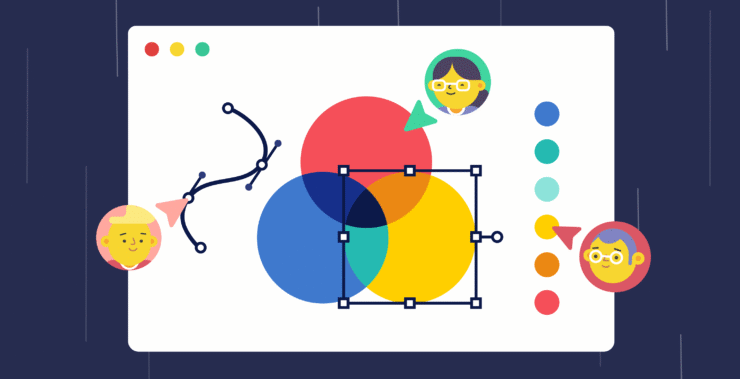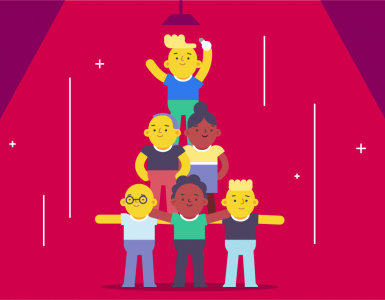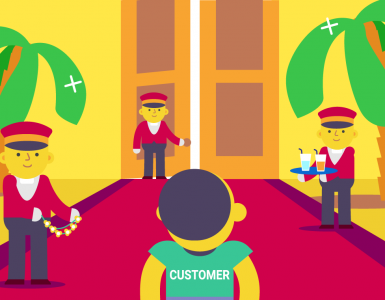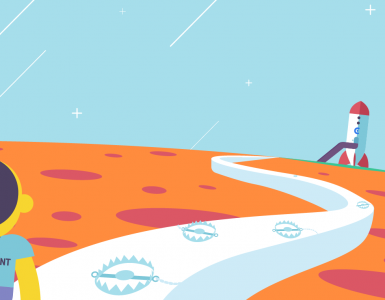You’re actively working on a project with your team, brainstorming ideas and looking for inspiration. And then, among many options, you come across a design that seems perfect for the next stage. You can’t wait to share it with your colleagues, so you quickly hit “send” and… chaos begins. Feedback comes from every which way, from the task board to an email thread to a comment in your messaging app. At the end of the day, that feedback is scattered, unclear, and feels more like a scavenger hunt than a productive process.
That is where design collaboration software changes everything. It creates one place to share, review, and fine-tune a design in order and with ease, not chasing comments down or sifting through updates.
In this article, we will discuss how design collaboration software revolutionizes creative workflows. If your team could use a little less chaos and a lot more clarity, keep reading – you’re in the right place.
Design collaboration software to look for in 2025
- Chanty – your all-in-one design collaboration tool
- Slack – a familiar name in team communication
- Trello – visual task management for design teams
- Monday.com – all-in-one work operating system for design projects
- Asana – powerful project management for creative teams
- Notion – flexible workspace for creative teams
- Figma – the ultimate design collaboration tool
- Zoom – bridging the gap in design collaboration
- Microsoft Whiteboard – simple, interactive design collaboration
- Miro – interactive whiteboarding for teams
- Canva – simplifying design collaboration for everyone
- Webflow – empowering designers and developers
- DesignWiz – Your Go-To Tool for Effortless Flyer Design
What is design collaboration software, and why does it matter?
Design collaboration software resembles a well-organized design studio. Here, teams can seamlessly share, refine and execute creative work. These tools are built specifically for designers, project managers, and stakeholders to work together effectively. Instead of sifting through disparate feedback or juggling multiple tools, everything happens in one central hub.
Think about the typical challenges of a design project. A concept is shared, but feedback comes in bits and pieces – from an email here, a quick message there, and a meeting that contradicts everything. On top of that, keeping track of the latest file version can feel like its own full-time job. With design collaboration software, these frustrations disappear. Feedback is clear and centralized, and all versions of your work stay organized and accessible.
No creative process works well without collaboration. Designs gain from the different perspectives coming together to shape them. But without the right tools, all this teamwork quickly turns into one big mess of confusion. Misaligned comments, missed revisions, and duplicated efforts not only waste time but also sap the creative energy needed to put an idea into reality.
Where, again, the need for design collaboration software kicks in-letting a team connect in real time, sharing thoughts directly on design with transparency in their progress. In this case, everyone knows what’s going on, what one should do, and how not to step on one’s colleague’s toes. It’s the flow where collaboration fuels creativity instead of complicating it. This is especially valuable when fostering real-time collaboration between design and content teams, ensuring that messaging and visuals evolve in sync. A seamless feedback loop between these functions reduces back-and-forth, speeds up approvals, and enhances the overall creative impact.
These tools make life easier and improve output. They give designers more space to work in, so they can do what they do best: create beautiful designs that stand out. In a creative world where clarity and efficiency are the beginning and end of everything, having the right tools will make all the difference.
Essential design collaboration tools for every stage of your creative workflow
Design collaboration isn’t just about sharing ideas – it’s about bringing those ideas to life, managing tasks effectively, and ensuring the whole team is on the same page. Here’s a closer look at some top tools that can elevate your team’s collaboration, no matter what phase of the project you’re in:
Chanty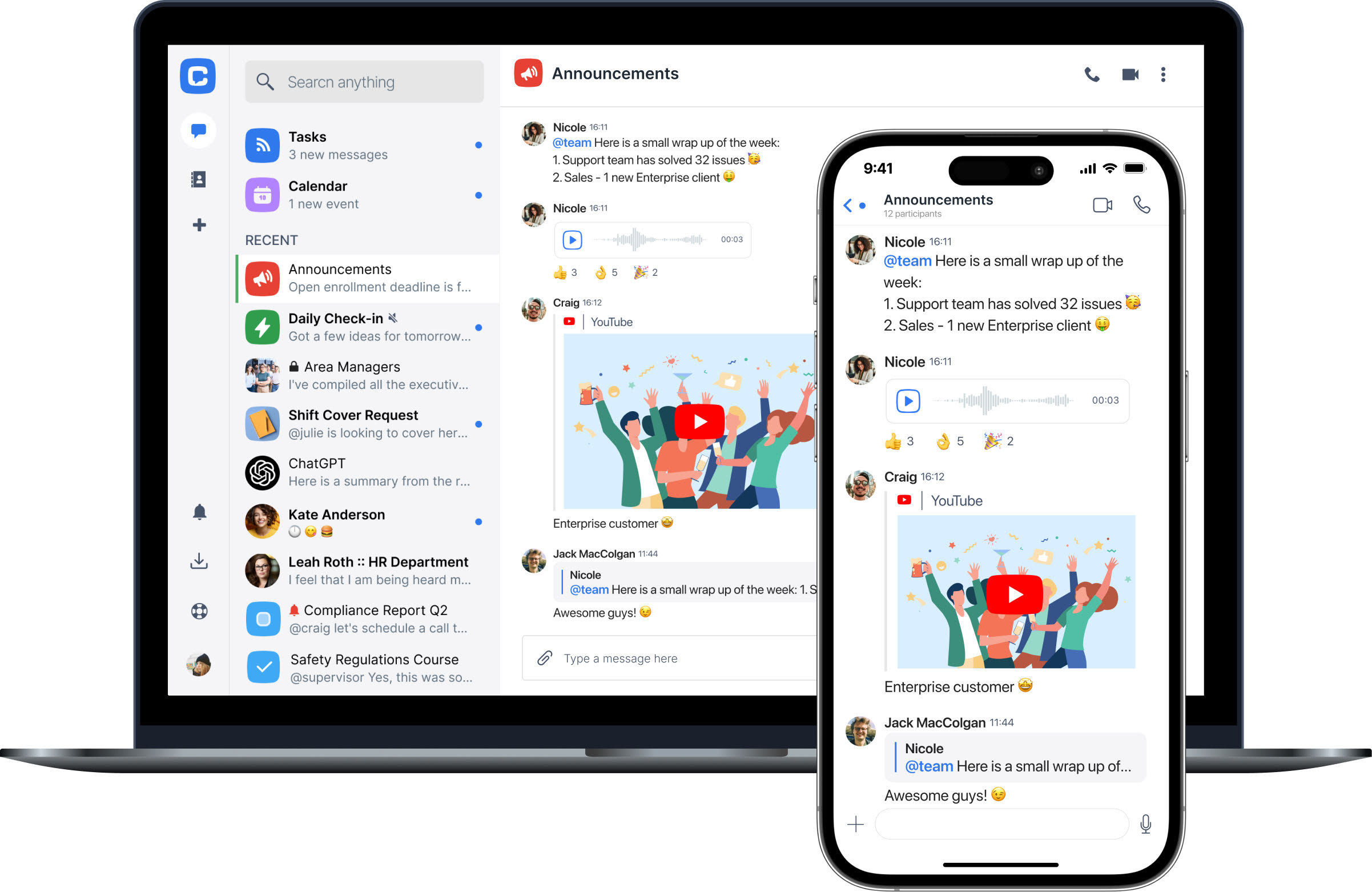 |
Designers know the struggle: endless email threads, scattered feedback, and trying to track down who said what (and when). Chanty fixes that. It’s not just another communication app; it is the bond that keeps your design team connected, putting projects on track.
Chanty allows you to have unlimited real-time conversations on any topic. Be it a discussion about logo redesign or a brainstorming session of a new campaign, everything stays in one single place, easy to navigate. But that is not all. Chanty is fitted with a built-in task manager that will let you turn any message into a task. Got feedback on a mockup? Assign it to the right person without leaving the chat. Even better, Chanty breaks down silos by enabling seamless cross-department collaboration – so marketing, content, design, and dev teams can stay aligned and move forward together.
Here’s how Chanty makes collaboration for design projects run smoothly:
- Unlimited messaging: Discuss every design detail with no limits to messages getting in the way.
- Built-in Kanban board: Keep your tasks visual and manageable. Great for creatives who like to see at a glance where things are.
- Voice and video calls: Perfect for those quick check-ins or presenting your ideas across the team.
- File sharing and storage: Upload and share your design files in seconds, zero fuss.
Chanty keeps your team organized, not overwhelmed. You will not spend your time chasing updates or digging through folders to find the latest version of a wireframe. Plus, the interface is super clean and intuitive, meaning no steep learning curve.
For design teams, Chanty simplifies the process of creating together. Feedback happens faster, tasks are clearer, and everyone’s in sync. It’s where designers, writers, and marketers can finally work as one unified team – with clarity, speed, and creative flow. It’s like having a project manager, communication tool, and task tracker in one – minus the hefty price tag or headaches.
Slack |
Slack has become synonymous with the term team communication, but where exactly does Slack stand concerning design collaboration? With a space to converse about projects, along with countless integrations to suit various other needs, Slack fits seamlessly in the endeavor to help designers keep at pace. . You can create channels for different projects, such as logo redesigns, website updates, or marketing visuals, and invite the right people to join the conversation.
The most distinctive features for designers include Slack’s powerful integrations ecosystem. Tools such as Miro, Figma, and Canva fit seamlessly into Slack, hence allowing you to preview designs, share updates, and collect feedback without hopping between apps. Suppose you were updating a wireframe examples in Figma; the integration allows you to share the latest version right within your project channel for instant input.
Here’s what designers often love about Slack:
- Threaded conversations: Keep feedback organized by responding directly to specific comments.
- File sharing: Upload and store design files directly in channels.
- Powerful integrations: Work with design tools like Adobe Creative Cloud, Figma, and Canva.
- Notifications: Get updates in real time for immediate responses.
That said, Slack is overwhelming because it’s real-time. For designers working on quite complex tasks, constant notifications are distracting. In return, though, its search functionality makes up for it by providing you with the quickest retrieval of shared links, feedback, or files.
Slack thrives when your design team is managing several different projects and becomes the epicenter of collaboration – just remember to set boundaries so information overload chaos doesn’t ensue.
Trello |
Design teams really love the simplicity of Trello.The visual organization that it enables, turning a design workflow into an interactive, visual board. Be it website design or branding and marketing material design, Trello is going to guide you through the process all the way to completion.
Designers can create boards for projects, breaking down projects into “To Do,” “In Progress,” and “Completed” lists. Cards are fully customizable with descriptions, due dates, checklists, and file attachments-perfect for keeping feedback, assets, and updates in one place. That is why Trello will be of great help for creative teams seeking to see things very visually clear and easily collaborative.
Here’s how Trello improves design collaboration:
- Drag-and-drop interface: Track tasks by moving them across boards.
- Collaboration and comments: Add notes directly to cards so feedback can be easily found.
- File attachments: Share design files and resources instantly with your team.
- Power-Ups: Increase functionality with integrations such as Slack, Figma, and Google Drive.
While Trello is great for smaller teams or freelancers, larger teams may need a bit more structure and scalability. That said, for those who need simple yet effective visual task management, Trello’s approach is perfect for organizing design projects from start to finish.
Monday.com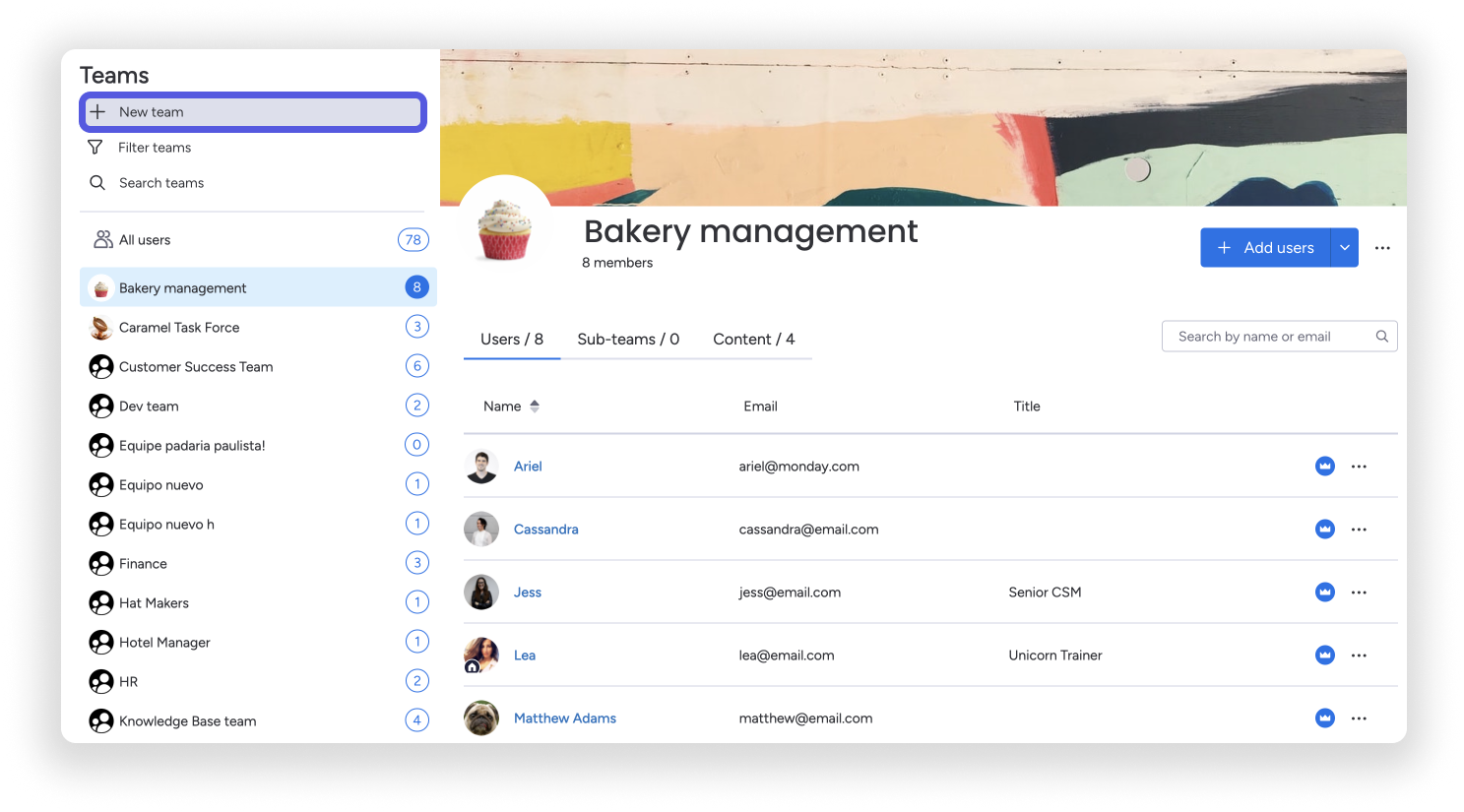 |
Monday.com is a work operating system, best suited to help the design team manage a project and collaborate in it. It’s flexible, user-friendly, and adapts to different workflows. That makes it so much easier to plan, track, and execute design projects seamlessly.
With Monday.com, design teams can create a tailored workflow for their needs: assigning tasks, tracking progress, and monitoring deadlines all in one spot. You can visualize your project on a Kanban, Gantt, or calendar for a variety of ways to keep your team on top of their work. This is especially useful for designers who have to balance multiple projects and tasks simultaneously.
Key features for design teams include:
- Customizable workflows: Tailor your process to suit your team’s unique design style.
- Multiple project views: Use Gantt charts, Kanban boards, or calendar views for different types of projects.
- Collaboration: Tag teammates in tasks, share design files, and comment right on the task.
- Automations: Reduce repetitive tasks with customizable automation that alert team members when it’s time to review or approve designs.
Although Monday.com is super powerful, it may take some time to master its features. But trust me, when this happens, it will be an excellent all-in-one tool to keep your design projects organized and flowing smoothly.
Asana |
Asana is one of the powerful tools that keep design teams organized and in tune with what is happening with their projects. With its friendly interface and high functionality in tracking projects, Asana lets design teams decompose projects into smaller tasks while being on track with deadlines.
It’s a great solution to manage everything from an initial concept down to the final design presentation. It lets teams organize work into projects, assign tasks, and collaborate on specific design elements. Asana will become of special worth for teams that need to track design feedback, revisions, and approval stages.
How Asana improves design collaboration:
- Project templates: Use ready-made templates for different design workflows to save time.
- Task management: Large design projects are broken down into tasks and subtasks with clarity at each stage.
- Timeline and calendar views: Easily track deadlines and project milestones.
- File sharing: Attach files directly to tasks so everything the designers need lives in one place.
Asana also integrates very well with a variety of design tools, including Figma, Adobe Creative Cloud, and Slack, letting your design process flow seamlessly across multiple platforms. While its full power comes out with bigger teams, even smaller teams will appreciate how Asana keeps everyone aligned with organized tasks and deadlines.
Notion
Notion is a powerful platform that binds note-taking, project management, and collaboration into one easy-to-use interface. For design teams, Notion is a powerhouse of creativity able to work with just about any workflow.
With Notion, designers can document their ideas, create mood boards, and track design iterations in a single workspace. Designers can organize their design assets with different kinds of databases, attach long descriptions to tasks, and even build project timelines. What really sets Notion apart, though, is how amazingly customizable it is, and how it gives a design team total control over how they structure and manage their projects.
Notion’s advantages for design collaboration:
- Custom databases: Organize your designs, files, and tasks your way.
- Documentation and note-taking: Keep detailed notes on design ideas, client feedback, and brainstorming sessions.
- Collaboration: Share pages and updates with your team in real time.
- Integration capabilities: Link to other apps such as Figma or Google Drive to keep things connected.
While Notion requires a bit of setup to tailor it for design teams, once configured, it becomes a powerful all-in-one platform to manage design projects and collaborate effectively.
Figma
Figma revolutionizes collaboration in design. Unlike most design tools, Figa actually was created to live in the cloud and make it easy for design teams to collaborate in real time. Several different designers can work on one project, making edits, giving feedback, and creating versions-mess-free.
Figma allows your design team to create everything from wireframes to high-fidelity prototypes – all in one tool. What’s even better? It is not just for designers. Developers and stakeholders can look at Figma projects too, thus enabling seamless collaboration flow across teams. This includes real-time collaboration between designers and content teams, ensuring that visual and textual elements evolve together without delays or disconnects. Figma allows designers to get real-time input from other team members because of its live commenting and feedback features, making the review process faster.
Here’s how Figma enhances design collaboration:
- Real-time collaboration: Multiple users can design and edit in the same file at the same time.
- Commenting and feedback: Team members can leave comments directly on the design, making feedback loud and clear.
- Prototyping: Create interactive prototypes for testing and presentations.
- Design systems: Create reusable components and styles that keep your designs consistent across teams.
Figma will be perfect for design teams that have to collaborate on projects that need high iterations involving each team’s input. Whether it be UI design, branding, or even web design, Figma would have one present comprehensive platforms that hold much more of a collaborative feeling and boast high productivity. Integrated with Slack and Notion, this would further streamline workflows and hence should be in your toolkit for any design team.
Zoom
You might already be familiar with Zoom from its use in meetings, but it’s got a lot more to offer than just video conferencing. For design teams, it’s the go-to platform for real-time discussions, presentations, and brainstorming sessions.
Be it a presentation to show a client a new design concept, discussing feedback from your team, or just about anything, Zoom makes it seamless. Screen sharing is particularly helpful for showing design mockups, prototypes, and even real-time brainstorming. What’s more, with integrations between Zoom and tools such as Slack and Figma, one can seamlessly move from design discussion to action: share your screen, pull in feedback, and edit without leaving the platform.
How Zoom improves design collaboration:
- Screen sharing: Easily present your design drafts, prototypes, and even live demos.
- Breakout rooms: Divide out into small groups to discuss pointedly during a design review or a brainstorming session.
- Virtual whiteboards: Draw, sketch concepts and ideas, and collaborate with others in real time on these virtual whiteboards.
- Record and transcribe: Keep a record of design meetings and discussions for future reference.
Zoom helps connected design teams make feedback and brainstorming truly effective. It is the perfect tool for distributed or remote teams, teams working from different locations; it’s easy for them to collaborate, share ideas, and refine designs in real time.
Microsoft Whiteboard
Microsoft Whiteboard is interactive and collaborative tool, perfect for sketching out ideas during brainstorming sessions. Designers often have to communicate their views visually, be it for a new design of a logo, a product, or even a user flow. The possibilities are endless with Microsoft Whiteboard.
It’s easy for teams to collaborate in real time on an unlimited canvas, where they can place sticky notes, draw shapes, and even doodle to visualize ideas. For those with a mind’s eye, Whiteboard is great to jump out of traditional design software in order to iterate on different ideas and workflows rapidly. Be it creating a rough sketch or fleshing out an idea, Whiteboard from Microsoft lets users capture their ideas in a smooth, effortless environment.
Here’s how Microsoft Whiteboard supports design collaboration:
- Real-time collaboration: Team members can add thoughts, sketches, and comments simultaneously.
- Infinite canvas: Enjoy unlimited space for sketching, brainstorming, and visualizing design ideas.
- Sticky notes and shapes: Organize your ideas with sticky notes, shapes, and freehand drawing.
- Integration with Office 365: Share your designs easily and collaborate with other Microsoft applications.
MS Whiteboard for a design team is a space to conceptualize and map ideas or even simple brainstorming. Ideal for when they want fast collaboration in visuals, without having to open sophisticated design software.
Miro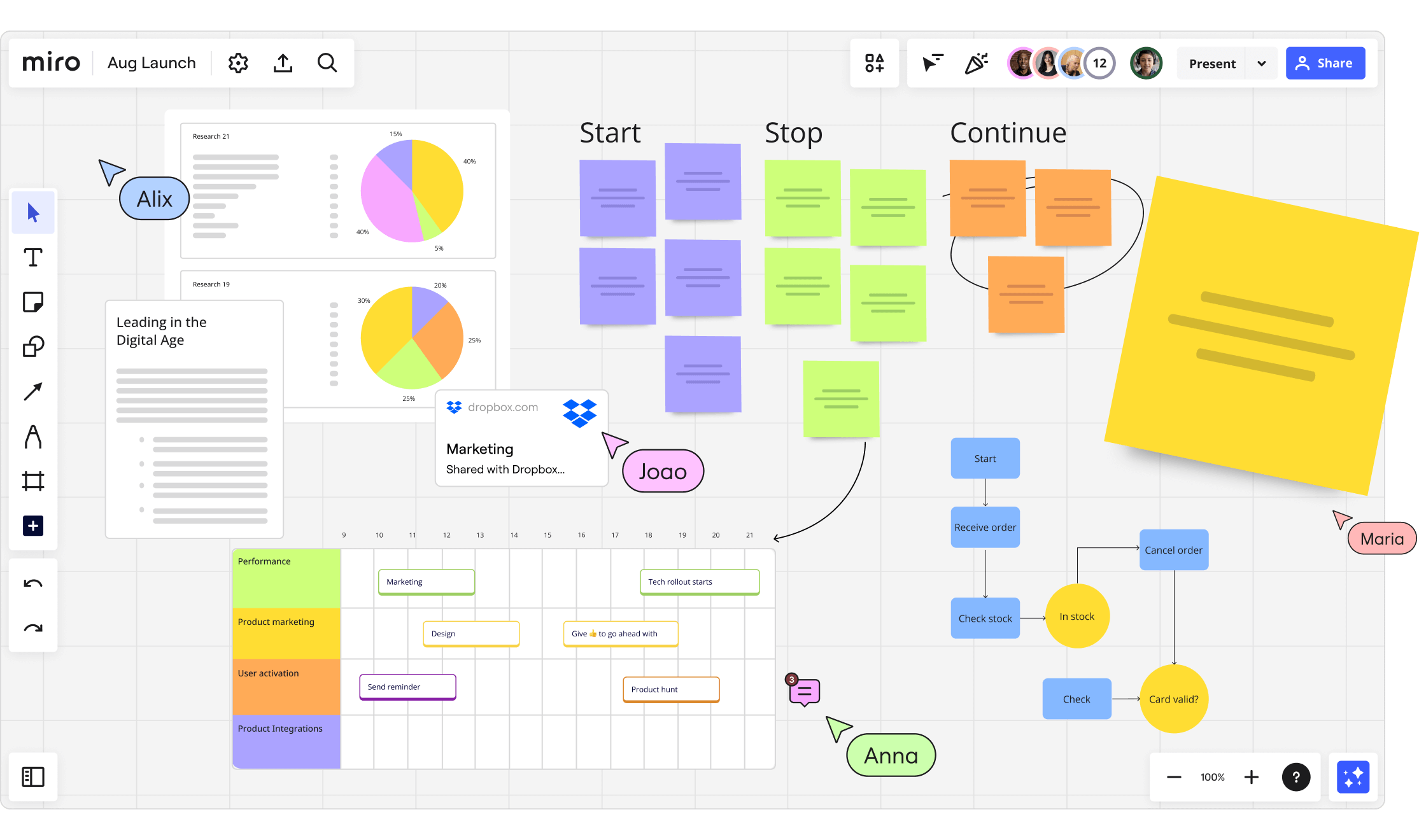 |
Miro takes the digital whiteboard and adds just the right amount of sophistication for collaborative design work. It is an online whiteboard tool where teams can meet up for brainstorming, mapping out user journeys, and the like in a highly interactive environment.
What sets Miro apart is how it marries simplicity with power. Designers can use it for creating wireframes, sticky note maps, and mood boards; they can even build user flows.
Miro’s standout features for design teams:
- Collaborative canvas: Create, edit, and comment in real-time on the same board.
- Templates: Use pre-designed templates for brainstorming, wireframing, and mind mapping.
- Integrations: Integrate it with Figma, Slack, and much more to keep the workflows flowing.
- Sticky notes and drawing tools: Organize your thoughts, ideas, and sketches.
Miro is an ideal platform where design teams can effectively brainstorm and visualize ideas in a powerful yet simple way. It fosters clarity, drives creativity, and enhances collaboration from that first brainstorming session to the final design review.
Canva
Canva is probably the most accessible design tool out there. It’s a super intuitive platform for both designers and non-designers. That’s because it’s known for the ease with which it allows users to make everything from social media graphics and presentations to even print material. However, Canva is also a powerful collaboration tool for design teams.
But one of the high strong points of Canva is team collaboration, enabling members to work in real time on any design. Be it for a marketing campaign, social media content, or brand guidelines, you invite your team in to design, comment, and edit in real time. With Canva, you’re able to assign roles within the design process so that everyone has the right level of control.
Canva design collaboration features:
- Real-time collaboration: Many team members can work on one design at the same time and thus share their ideas and provide feedback easily.
- Templates: Leverage customizable templates to speed up design work and keep your brand consistent.
- Commenting and feedback: Team members are able to comment directly on the design for clear, actionable feedback.
- Branding tools: Easily maintain brand consistency with brand kits that include logos, colors, and fonts.
Canva is ideal for any design team in need of something swift and easy with which to make and share their designs. From the simplest post on social media to bigger projects with marketing campaigns, Canva ensures the creation, collaboration, and coherence of its group on one wavelength.
Webflow
Webflow is a great platform for web design. It helps designers minimize coding in the website development process. For design teams, Webflow is a great tool to make responsive websites interactive while having complete control over the development process. Webflow is unique in that it allows you to develop and even launch websites using this very platform. Design, development and deployment in one place.
Webflow allows designers to create amazing websites using an intuitive visual interface while giving developers the freedom to fine-tune the code. This is why Webflow is an ideal solution for those teams who have to work in close collaboration on interactive web design projects. The real-time collaboration feature within allows both designers and developers to seamlessly work together by making live changes and edits.
Key features of Webflow for design collaboration:
- Visual design tools: Create responsive websites by drag-and-drop, without coding.
- Collaborative editing: Work on the same project in real-time collaboration with your team.
- Design to code: Design accurately and export clean code for development.
- CMS features: Manage dynamic content with the help of the Content Management System, making the workflow easier.
Webflow helps design teams make their web design process more efficient by offering a peculiar combination of design flexibility and development capability. Real-time collaboration in this platform makes it ideal for teams dealing with dynamic, interactive websites and smooth design-to-development handovers.
DesignWiz
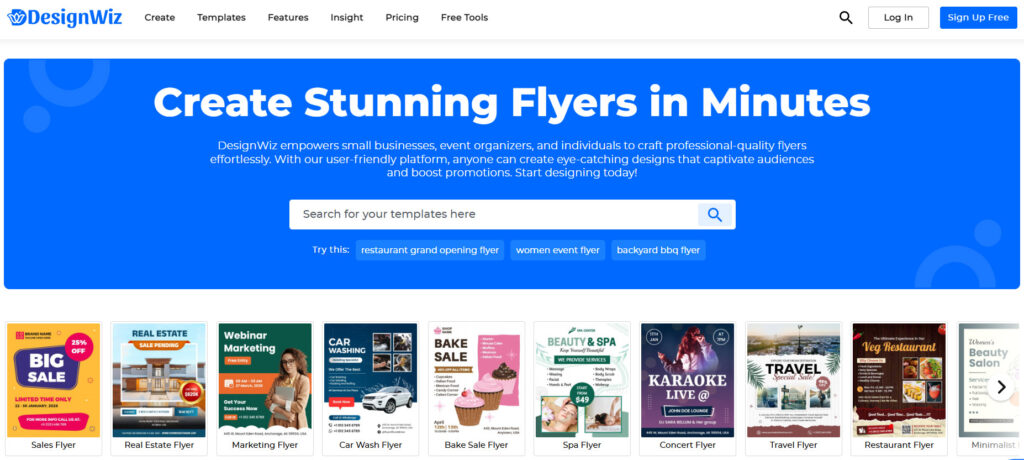
DesignWiz is a user-friendly flyer-making tool that simplifies the design process for both professionals and beginners. It provides a vast collection of editable flyer templates, making it easy to create stunning promotional flyers, event announcements, or business materials in minutes. Whether you need a quick design for marketing campaigns or detailed visuals for an event, DesignWiz ensures a seamless design experience.
But what truly sets DesignWiz apart is its ease of use and efficiency. With its drag-and-drop editor, users can personalize templates effortlessly, incorporating logos, colors, and brand elements to maintain consistency. Whether you’re working solo or with a team, DesignWiz makes flyer creation a hassle-free experience.
DesignWiz Features for Streamlined Flyer Creation:
- Customizable Templates – A wide range of templates for different industries and events to speed up design work.
- Easy Editing – Drag-and-drop functionality for quick modifications, even without prior design skills.
- Brand Consistency – Allows you to add brand logos, fonts, and colors to ensure uniformity across all designs.
- Print & Digital Ready – Download flyers in high-quality formats for both online sharing and physical printing.
DesignWiz is the perfect tool for businesses, event organizers, and marketers who need a fast and simple way to create professional flyers. Whether you’re promoting an event or designing marketing materials, DesignWiz makes the process smooth and efficient.
Final word
In short, today the art of design collaboration lies in using the right tools for the right need that one’s team is trying to fill. Canva, Figma, and Webflow get designers collaborating through building, editing, and even giving feedback on your projects in real time. Smoother teamwork always tends to create greater magic-faster output, freely flowing creative juices, and better work overall. This is especially true for collaborative design projects that require multiple inputs, quick turnarounds, and a high degree of creative alignment. With the rise of remote teams, online design collaboration has become not just convenient but essential.
Here’s how you can immediately boost your design collaboration:
- Choose the tool that better flows into your workflow: Whether it’s a more visually-oriented design tool like Canva, or an interactive platform like Webflow, make sure the tool best suits serving the needs of your team.
- Centralize feedback: Commenting allows feedback to be in one place. This keeps your team focused and reduces miscommunication.
- Leverage real-time collaboration: the faster your team can make changes and discuss ideas, the faster your designs will evolve.
- Stay organized: All project files, assets, and plans are easily accessible and well-labeled, so nobody needlessly wastes any time trying to find the right materials.
Want to take your design collaboration to the next level? Try Chanty – a perfect tool that helps simplify the process of communication and organization of workflow. From instant messaging, task management to seamless integrations, Chanty allows your team to stay updated on all project affairs. Create a free workspace and see for yourself how it could elevate your design projects.



